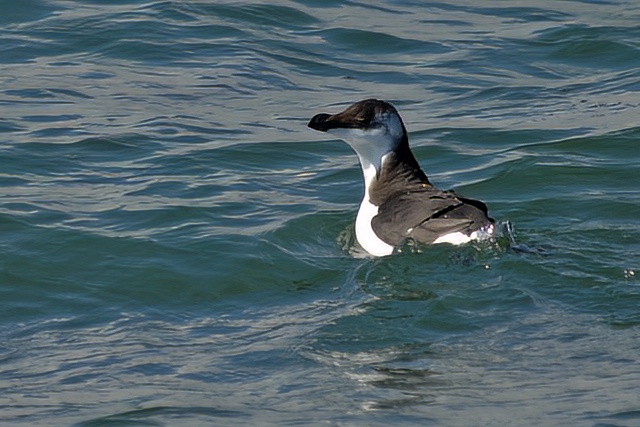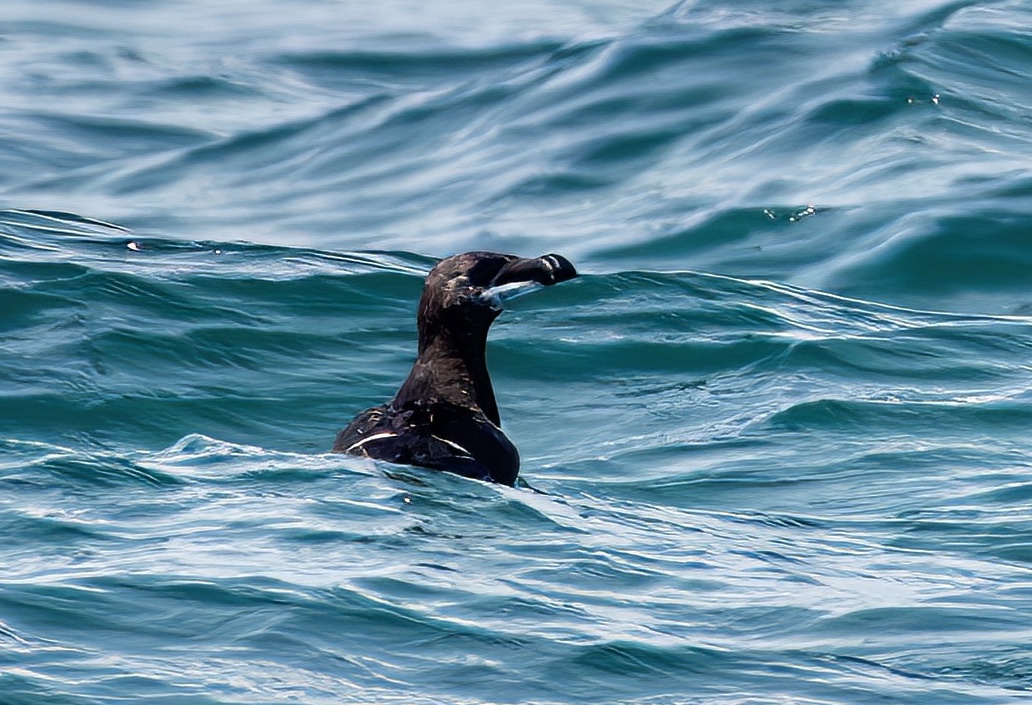Razorbill Alca torda
Western European form (islandica) scarce passage migrant and winter visitor but can occur in any month. Exceptional inland.


The Atlas reported that the wreck of February 1983 included 2,510 Razorbills (see article, below), an astonishingly high figure, given the relative scarcity of this species compared to Guillemot, Uria aalge, in the North Sea. LBR reports for the 5 years to 2018 showed that the yearly total of peak counts ranged from a low of 15 in 2015 to a high of 80 in 2016 with an average of 40 birds per year. The largest count each year was from Gibraltar Point with an overall high of 43 on June 2nd, 2014. On June 1st, 2016 Gibraltar Point had 23 and on the same day 18 were counted moving north at Saltfleetby-Theddlethorpe NNR; interestingly, at locations like this in the 1980s and 1990s, warm onshore breezes in July would often reveal Razorbills with chicks, a phenomenon unseen in the 5 years to 2018. Interestingly, a recent LBC North Sea pelagic trip venturing as far out as the Silver Pit (the long valley in the seabed 28 miles east of Spurn Head) found this species with chicks in small numbers, but there have been no recent reports of this phenomenon from land-based observers.This is surprising given Razorbills breed 40 miles to the north of the Humber Mouth in the Flamborough / Bempton area. Some 28,000 birds were counted there in 2017 and that site holds the fastest growing population in the UK according to the Seabird Monitoring Programme. Birds ringed in Scotland and its islands feature heavily in the list of recoveries in the county, and five such recoveries were made after the wreck of 1983, four of Shetland-ringed chicks, one from the Western Isles. Foreign-ringed birds have come from Finland, Iceland and Norway.
The Auk wreck, February 1983
by R. Lambert
Note: This account is based on the article which first appeared in Lincolnshire Bird Report, 1983.
Early in February it became apparent that small numbers of birds were being washed ashore along the coast of Lincolnshire and South Humberside. The birds were mainly auks, with attention being focused initially on that little-seen species, the Little Auk, of which there were even a few inland records. Other species involved were mainly Razorbills, Guillemots, Puffins and Kittiwakes. Contrary to immediate assumptions however, there appeared to be little evidence of oiling – subsequent figures revealing <10% of birds were oiled, and only lightly so when present. It was soon apparent that we were seeing the first victims of a natural disaster in the seabird world. As more corpses, and a few live but very weak birds, drifted up on to the beaches on the fresh NE winds, it became essential to try to make some assessment of the numbers involved. Parts of the coast are censused on a monthly basis each winter as part of the Beached Bird Survey organised by the RSPB, but this was happening mid-way between counts. Arrangements were therefore made to cover as much of the coast as was possible. In the event the whole coast from Cleethorpes to the Lincolnshire/Norfolk border was surveyed, although there were a number of small gaps where extensive saltmarsh prevented accurate counts from being made. There were also several duplicated counts, and the overall picture very quickly became confused as some observers were removing birds from the beach while others were not. In addition, the main counts were made during the week February 13th-20th and since it is evident from repeat counts that many more birds were coming ashore at the end of that week and the next, the numbers shown should be regarded as minimum counts. In fact, if the repeat counts in the north of the county are indicative of the coast as a whole, the numbers involved were substantially higher than shown. Above Cleethorpes a less intensive search was made, but very few corpses apparently made their way into the Humber, and none above Goxhill though the search extended to South Ferriby.
Such ‘wrecks’ of auks seem to occur fairly regularly, perhaps on a ten-year cycle though the present one may well set a number of records, partly as a result of the intensive efforts to accumulate the available data. A complete explanation may take some time to be arrived at, but it would appear that the blame can be placed jointly upon a food shortage in some areas of the North Sea, coupled with prevailing weather conditions in February. These held birds in the region where they were unable to find food so that thousands starved or succumbed to exposure.
| Species | Cleethorpes-Saltfleet Haven | Saltfleet Haven-Gibraltar Point | Gibraltar Point-Norfolk border | Total |
| Razorbill | 1291 | 720 | 499 | 2510 |
| Guillemot | 476 | 259 | 375 | 1100 |
| Puffin | 165 | 67 | 52 | 284 |
| Little Auk | 109 | 50 | 41 | 200 |
| Kittiwake | 67 | 39 | 72 | 178 |
| Fulmar | 6 | 1 | 13 | 20 |
| Gannet | - | 1 | - | 1 |
| Gull sp. | 8 | 7 | 52 | 67 |
| Waders | 2 | - | 24 | 26 |
| Diver sp. | - | - | 3 | 3 |
| Ducks | 1 | - | 9 | 10 |
| Geese/swans | - | - | 4 | 4 |
Footnote: the wreck affected the whole of the east coast and in February 1983 some 18,000 Razorbills, 10,000 Guillemots, and 1,600 Puffins were washed ashore from Orkney to Kent. Ringing recoveries indicated that most of the Puffins came from colonies adjacent to the North Sea whereas Razorbills and Guillemots came from both local and distant colonies (Harris & Wanless 1984).
Reference
Harris, M. P. and Wanless, S. (1984). The effect of the wreck of seabirds in February 1983 on auk populations on the Isle of May (Fife). Bird Study 31: 103-110.
(Species account as per new Birds of Lincolnshire (2021), included September 2022; 'Auk wreck, Feb 1983' added June 2023)
